
Discovery of the M31 [OIII] emission arc
Recently, a major discovery by an international team of amateur astronomers and scientists has become a huge online hit, and this new discovery is just located in one of the

Hello Gary, thanks for accepting our interview invitation. Congratulations on winning the ASIWEEK competition in week #12/2024!
Thank you! I’ve been seriously involved in astrophotography since the winter of 2020. The timing coincided with the pandemic onset, but that’s not why I took up the hobby. I began putting my kit together in late 2019 when I was considering retirement, not knowing how fortuitous my decision was. Professionally, I’m an anthropological archaeologist. That means I was an archaeologist working in a Department of Anthropology, in my case at the University of Toronto’s Mississauga campus. I’ve been investigating early cultures in Ontario, Canada, and in China and Japan, so I’ve lived in some amazing places. I’m retired now, enjoying the freedom that comes with it. My family loved the outdoors, hiking and canoeing especially, and whenever we travelled, we camped. No hotels for us if we could help it. That must be how I became interested in the night sky, spending many summer nights camping under the stars. Part of my childhood unfolded in northeastern France because my father was in the Royal Canadian Air Force and we lived in St. Avold, not far from where he was based. I must have been interested in astronomy at the time, because I still have a book that my grandparents gave to me at the time, Fred Hoyle’s 1961 classic volume on astronomy. I guess my parents got tired of being unable to answer my questions about the universe and my grandparents stepped in and bought me the book for Christmas in 1962. It was a difficult read for a 10-year-old, but I remember giving it a shot and it must have stuck with me. My friends and I started an astronomy club in high school, and we’d occasionally have observing nights. I had a Unitron refractor and my father built a pier for it in our backyard. We had very little money and whatever money I had was being put away to go to university. I had to sell the telescope when I went to university so astrophotography was out of the question. My father bought me a Voigtlander 35mm camera when we were in France, so I started learning about photography when I was in elementary school. Most of my family was involved in photography, so it was easy to learn with so many mentors around. One of my uncles worked for a newspaper and was an accomplished photographer. I can still remember him teaching me about framing a shot. But I still had never taken a photo of the night sky.
For more information, I’m archiving my photos at http://gwc.smugmug.com and my professional page is http://profgarycrawford.ca .

I have a long-standing interest in the human condition. Being an archaeologist, I’m interested in everything that’s science. My specialty is understanding the relationships between ancient ecology, plants, and people. So, as an undergraduate, I studied all three areas. I’m curious about everything. From a technical perspective, my research demanded technical photographic, especially microscope photography. I’ve always been interested in pushing the limits of my photography skills, so astrophotography fits the bill. Quite a few of my archaeology colleagues are interested in astronomy too, and what we seem to share is a curiosity about time and space. We even have a subdiscipline called “archeoastronomy”, a research area that explores the connection between ancient people and the stars, moon, planets, and sun. Over the years I’ve lectured on this fascinating topic but have never done any research related to the subject myself. But I appreciate what my colleagues are doing. On top of all that, I have always been curious about the broad cultural aspects of being human as well as our evolution on this planet. So, astronomy and astrophotography are an extension of my personal effort to understand the human condition through time and space, space not in the astronomical sense but in the sense of context. When I’m photographing a particular target, for example, the Orion Nebula, I think about what our ancestors were doing when photons were leaving the nebula. It takes light roughly 1300 years to reach us and I’ve worked on several archaeological sites dating to about 1300 years ago in Canada and in Japan. In Ontario, Iroquoian culture was developing from its ancestors and in northern Japan, coincidentally, the ancestors of the Indigenous culture of Hokkaido (the Ainu), were establishing a foundation that would last into the present. Another great example is the Andromeda Galaxy. The light we see today was beginning its journey to Earth at the dawn of humanity.

M42 in Orion imaged with my ASI2600MC Pro.
I have several telescopes spanning a range of focal lengths: Spacecat (250 mm f/l), Starfield Gear 80 (480 mm), Meade 6000 series APO (800 mm), William Optics FL156 (1200 mm), and a Meade 10″ LX850 that I use mainly for planetary and lunar imaging. You’ll often find me imaging with 2 or three of them at a time. I’ll shoot the same target in narrowband and in RGB with an OSC camera and then image a 3rd target in RGB at the same time. I have a Daystar Quark Chromosphere and enjoy solar imaging. I started solar observing when I was in high school and I’m blown away by the solar imaging tools backyard astronomers have at their disposal today. Lately, I’ve started nightscape imaging because I have some great opportunities nearby. I have an astro-modified Nikon Z6ii. My favourite lenses are the Z series Nikkor 35mm and 24-70mm lenses, as well as the new E-mount Sigma 20mm lens. Lately, I’ve been using the Z6ii with the Nomad tracker. I can put the tracker in a small section of my camera bag when I travel. It weighs almost nothing but is a powerhouse. I have two permanent setups at home, one in a SkyShed POD and another in a roll-off roof observatory built from SkyShed plans I got from its designer, Wayne Parker. I feel rather spoiled, to say the least, but life is all too short not to be all in.
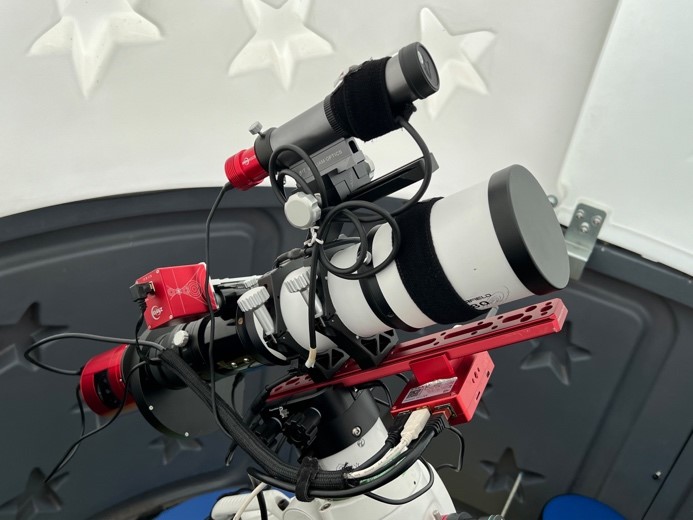
My Starfield Gear 80 in my SkyShed POD with quite a few ZWO products: ASI2600MM Pro, ASI220 Mini, EFW, EAF, and ASIAIR.

This is my SkyShed setup: William Optics FL156 with an ASI2400MC Pro, Guide Star 61 with an ASI174MM, PrimaLuce Labs Sesto Senso 2 focuser, PrimaLuce Labs Eagle 4 Pro, and iOptron CEM120.
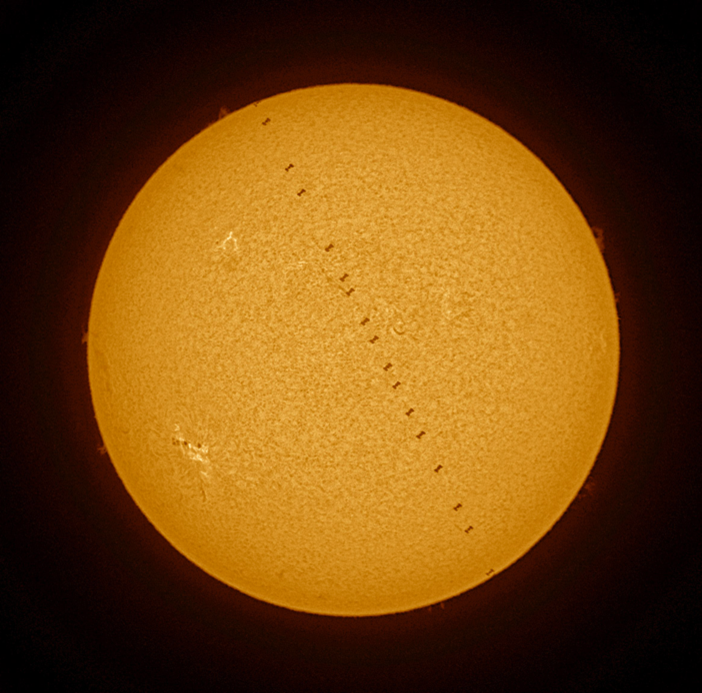
I shot this ISS transit from a parking lot in Mississauga, Ontario in 2021 with my ASI144MM and a double-stacked Lunt LS80T. The processor on my laptop wasn’t the best so a few frames were dropped.
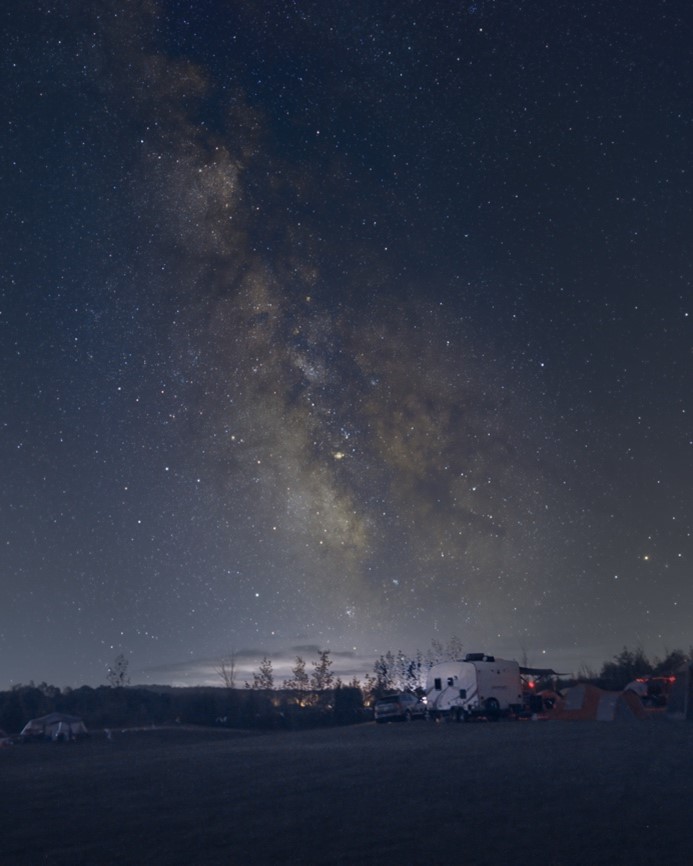
This is a tracked and stacked Milky Way photo I shot with my ASI2600MC Pro and a 20 mm Sigma lens in August, 2022 at Starfest in Ontario. The foreground is an untracked, separate shot.
I have quite a few ZWO products. I have a few ASIAIRs (Pro and Plus), several cameras (ASI2600MM Pro, ASI2600 MC Pro, 2400MC Pro, 174MM and several guide cameras), three EAFs, a ZWO OAG, and EFW. My first ASI camera was the 174MM. I use it with a Daystar Quark Chromosphere.
For the first couple of years during the pandemic, I was doing astrophotography in a horribly light-polluted environment that I have since left. Not only was the light pollution horrific, the maple tree that I planted just before the birth of my son is now a giant, mature tree that blocks much of the southern sky from my old backyard. Then there were my neighbours’ houses that restricted what I could see. So, I decided to pack up and move. I landed on a beautiful place near the north shore of Lake Erie in a town called Lowbanks. The skies are incredibly clear, ranging from Bortle 4 to the north and northeast to Bortle 2 or3 over Lake Erie. There are so many amazing targets in the southern sky that that’s where I’ve been concentrating my efforts since I moved. I go to a Provincial Park nearby where I can set up on the beach and shoot unobstructed views of the Milky Way with the rocky shoreline in the foreground. I get amazing views of the Milky Way from my home too. Last May I had an opportunity to go to the Atacama Desert for an astrophotography workshop with Yuri Beletsky and Kerry-Ann Lecky Hepburn. It was transformative, because it was the first time I was able to seriously learn about the skies in the southern hemisphere and to get great instruction.
I think back to the times I was doing fieldwork in areas with amazing skies but never considered photographing them. I’m trying to figure out a way to make up for lost time by returning and photographing some of the sites I worked on but this time against the night sky. I wish I had another lifetime ahead of me.
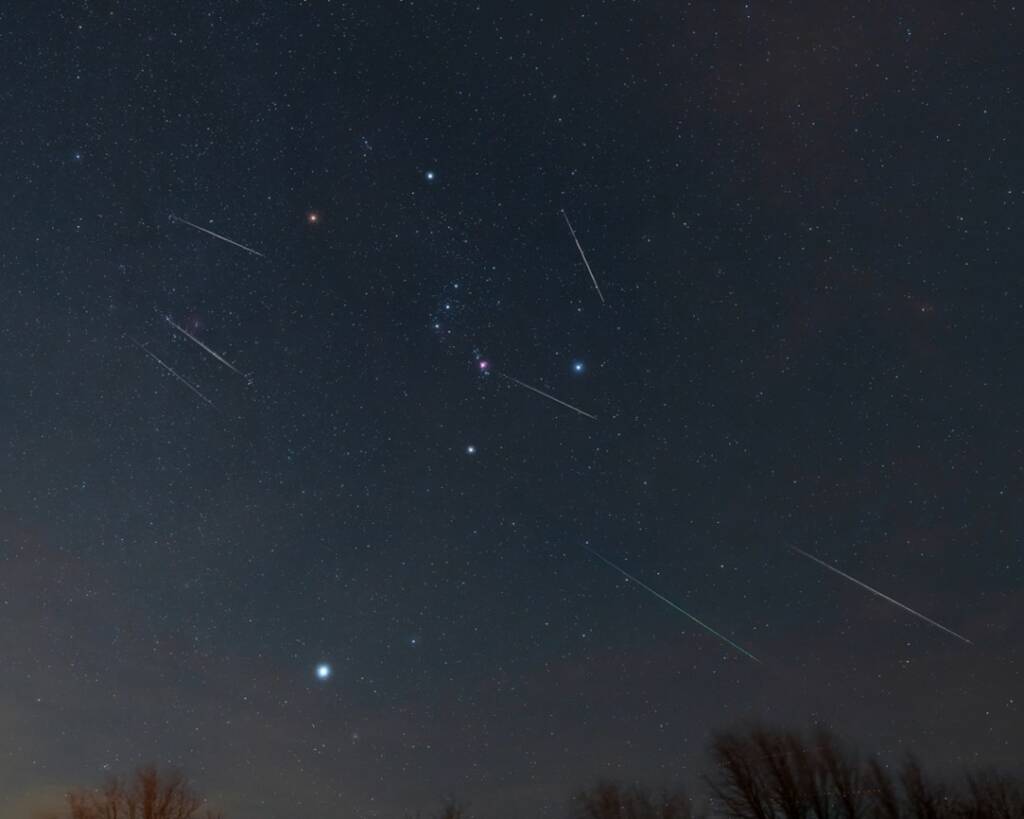
The skies over my neighborhood during a meteor shower.
It’s almost a requisite target for astrophotographers so I wanted to do something a little different. I tried imaging it before from the city but always fought the weather and trees that joined forces with the light pollution to conspire against me. Given its complexity, with the Flame Nebula, the bright star in Orion’s belt, Alnitak, several emission nebulae, the dust lanes, and the streaming nebulosity around the Horsehead I knew it would be a challenge under the best conditions. I was aware of the clouds of nebulosity in the background so wanted to bring them out. Most images I see set the Horsehead and Flame Nebula against almost featureless dark space. So I combined RGB data taken with my ASI2400MC Pro with H-alpha data from my ASI2600MM Pro and an Antlia 3.5 nm filter.
I started with RGB in late November and captured the Ha over a few nights in December when the wind was howling and most normal people were ensconced indoors (as I was after I set up). Fortunately, my POD dome blocked most of the wind. The total integration time is about 12 hrs, with high resolution RGB data captured with my ASI2400MC Pro and William Optics 156mm APO mounted on a SkyShed pier from my SkyShed. I captured the H-alpha data with my ASI2600MM pro and Starfield Gear 80 from my SkyShed POD.
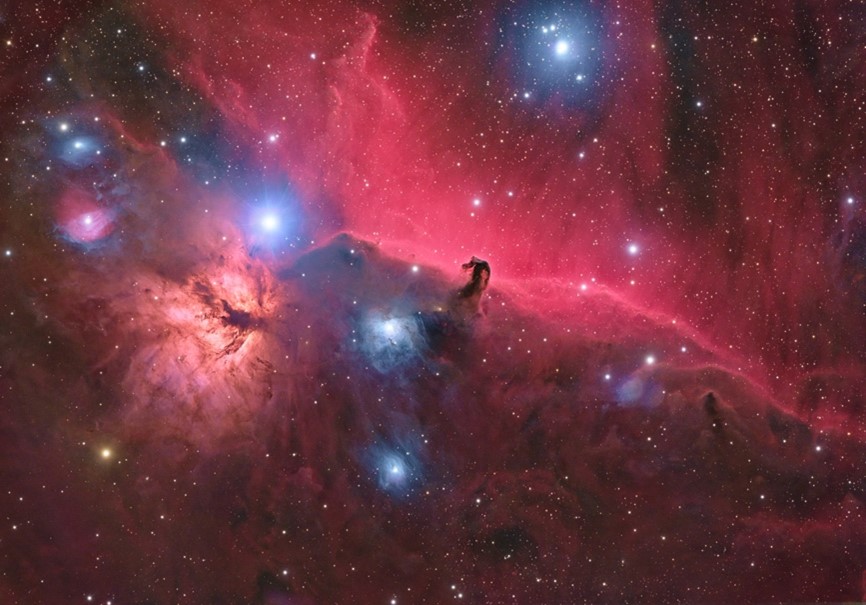
I can spend anywhere from an hour or less, to many hours processing, not including the time it takes to calibrate and stack. I’ll do a quick run-through to see where it takes the image. That tells me what the potential in the image is, and then I go back and tweak the processing. I’ll study others’ results (on Astrobin for example) to see what the image could look like and what I might be able to do that’s unique from artistry and technical perspectives.
The most difficult part for me is stretching the linear image. That’s where the difference between an ok photo and a great photo happens. I’ll try a couple of different methods in PixInsight to see what works best. I find that HTF works well most of the time, but in complex situations I prefer GHS. If I shoot a mosaic, the stitching can be tricky. I prefer Astro Pixel Processor over PixInsight for stitching mosaics.
Nightscape imaging is a different animal. It can take even longer because I usually shoot mosaics with a 35mm lens. I spend many hours trying to get a mosaic that I’m satisfied with. I use PTGui Pro for complex nightscape mosaics, and then I’ll switch between Adobe Lightroom and PixInsight for the processing, with some tweaking in Photoshop.
Being retired this doesn’t present an issue at all. I can’t imagine how my astrophotography friends who are still working full time and have young families do it. They have my respect. I can stay up as long as I want, get up anytime of the night I want, and nap during the day anytime I want. It doesn’t get much better. During stretches of bad weather, which is most of the time, I can continue my writing and other pursuits (hiking, standup paddle boarding, kayaking, and nature and street photography).
Astrophotography is a solitary pursuit for me, although not on purpose. My friends and family like to see the results and occasionally a friend or family member joins me for nightscape photography and I enjoy the company and sharing the experience. Family members will check out what I’m doing, but they tend to prefer the comfort of home. I monitor what’s happening from inside my house after I start an imaging session, so I can show friends and family what I’m capturing in real-time. My son took an astronomy course in university, so at least he understands and appreciates what I’m doing.
In general, don’t depend on social media if it can be helped. Read books like The Backyard Astronomer’s Guide by Terence Dickinson and Alan Dyer. Talk to your equipment retailer about setting up and any equipment issues you might be having before asking on social media. Beyond that, experiment on your own as much as possible. It’s a journey that takes time, so enjoy the ride. Learn from the results. I find that a lot of online advice is apocryphal and occasionally rude and judgmental. Avoid any advice beginning with “I’ve heard that…” Be sure to get the reasoning and even the data behind any advice (in my business it’s the equivalent of asking for the citation) before accepting something you read online. Learn who the trusted sources are. I have found that independent problem-solving is a satisfying part of the journey. Experimenting can be extremely edifying, and even fun at times. I tend to retain what I learn by experimentation much better than when I read about best practices.
Smart/robotic telescopes are going to make astrophotography far more accessible to a wider range of people than they are today. Learning the jargon (I always thought that a “flat” was an apartment!) and figuring out how to fit all the pieces of gear together were my two main frustrations getting into the hobby. All specialties have their jargon, so I took the time and eventually learned it. Having a lot of technical knowledge about photography, I thought “what could be so hard?” I was soon to find out. On top of that, the archaic divide among computer platforms is unacceptable in the 21st century. Some of the best software is cross-platform. There’s no excuse for equipment and software to be wedded to a particular platform. ASIStudio is multiplatform, as are PixInsight, Firecapture, and Astro Pixel Processor. It’s a good reason to consider the ASIAIR system when starting out, although it’s a shame that only ZWO gear, other than mounts, is supported. When I stepped into astrophotography, I felt like I was going back in time 20 or 30 years. Robotic telescopes will be great as long as photographers can maintain significant control. Young people who might like to get into the hobby are accustomed to technology but are just as accustomed to processes being simplified. I think they’re going to drive a lot of the changes we’ll see down the road. The older we get, the more we’ll appreciate it too. It’s not as easy to lug around heavy mounts and telescopes once arthritis and back issues become a concern. Robotic gear may well keep us in the game longer. There will always be people who want to continue with the old ways and that’s fine. Streamlined approaches and our current complex approaches will live side by side for a long time.
Finally, climate change seems to be having a significant impact on cloud patterns and wildfires. The number of clear nights available for many of us seems to be fewer and fewer over the years. So, I have a feeling that astrotourism is about to take off. I’ve already started by travelling to Chile and Arizona. Companies that develop great portable lines of astrophotography gear won’t regret the investment.
I turn to ZWO first when I’m thinking about upgrades or new peripherals. I can count on the ZWO ecosystem. Furthermore, ZWO is run by dedicated individuals with a passion for astrophotography. I occasionally see complaints about customer service on social media but that hasn’t been my experience. Over the years I’ve had only a few issues and ZWO customer support always came through for me. Beyond this, I wonder about some camera redesigns. For example, camera tilt adjustment is awkward. Fan vibration in the 2600 series has been a problem for some people so better isolation of the fan could be implemented. I wish sensors with very small pixels were more common so that under-sampling in popular short focal-length scopes wasn’t as much of an issue. But that’s industry wide. I also wish the WIFI range of ASIAIRs was better. Yes, there are workarounds and I’ve implemented them but it’s yet another step to add to the otherwise complex workflow. I have a competitor’s focuser on my WO156. Its WIFI signal, without an external antenna and encased in metal, is accessible all over my property yet I rarely need to use its WIFI. When I do, it’s infallible. Finally, I’d love to see a ZWO rotator. The main reason I need to stay outside longer than necessary in the cold during the winter months and among the mosquitoes in the summer is to adjust my framing. Warmth and not being a blood source for insects is rather appealing.

Recently, a major discovery by an international team of amateur astronomers and scientists has become a huge online hit, and this new discovery is just located in one of the
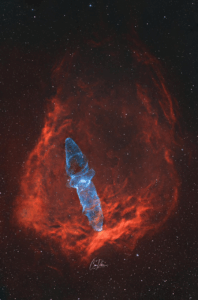
To most people, this might just look like a pretty picture. But to astrophotographer Cem Diken, it’s the result of three years of chasing a nearly invisible ghost in the

I was born in Guadalajara, I’m 38 years old, a musician, communications and electronics engineer, and president of the Guadalajara Astronomical Society A.C. since 2020. First Contact with Astronomy Since
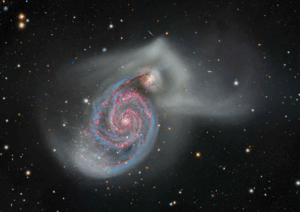
This stunning collaborative project comes from astrophotographers Alex Linde and Thomas Hansson, who joined forces across borders to photograph the Whirlpool Galaxy from Sweden, Poland, and Texas, USA. Thomas traveled across
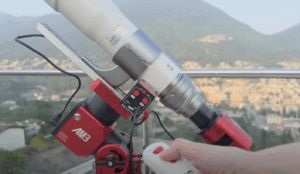
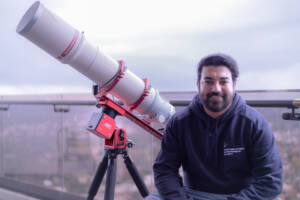
“Two thoughts immediately crossed my mind—the vastness of the cosmos, and that I could also create images like the ones that inspired me.” ” If you spend more time debugging than